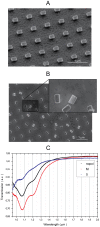Water-dispersible three-dimensional LC-nanoresonators
- PMID: 25153993
- PMCID: PMC4143276
- DOI: 10.1371/journal.pone.0105474
Water-dispersible three-dimensional LC-nanoresonators
Abstract
Nanolithography techniques enable the fabrication of complex nanodevices that can be used for biosensing purposes. However, these devices are normally supported by a substrate and their use is limited to in vitro applications. Following a top-down procedure, we designed and fabricated composite inductance-capacitance (LC) nanoresonators that can be detached from their substrate and dispersed in water. The multimaterial composition of these resonators makes it possible to differentially functionalize different parts of the device to obtain stable aqueous suspensions and multi-sensing capabilities. For the first time, we demonstrate detection of these devices in an aqueous environment, and we show that they can be sensitized to their local environment and to chemical binding of specific molecular moieties. The possibility to optically probe the nanoresonator resonance in liquid dispersions paves the way to a variety of new applications, including injection into living organisms for in vivo sensing and imaging.
Conflict of interest statement
Figures





References
-
- Schuller JA, Barnard ES, Cai W, Jun YC, White JS, et al. (2010) Plasmonics for extreme light concentration. Nat Mater 9: 193–204. - PubMed
-
- Lemoult F, Kaina N, Fink M, Lerosey G (2003) Wave propagation control at the deep subwavelength scale in metamaterials. Nat Phys 9: 55–60.
-
- Jakšić Z, Jakšić O, Djurić Z, Kment C (2007) A consideration of the use of metamaterials for sensing applications: field fluctuations and ultimate performance. J Opt A: Pure Appl Opt 9: S377–S384.
-
- Kumar S, Harrison N, Kortum RR, Sokolov K (2007) Plasmonic Nanosensors for Imaging Intracellular Biomarkers in Live Cell. Nano Lett 7 (5): 1338–1343. - PubMed
-
- Anker JN, Hall WP, Lyandres O, Shah NC, Zhao J, et al. (2008) Biosensing with plasmonic nanosensors. Nat Mater 7: 442–453. - PubMed
Publication types
MeSH terms
Substances
Grants and funding
LinkOut - more resources
Full Text Sources
Other Literature Sources

